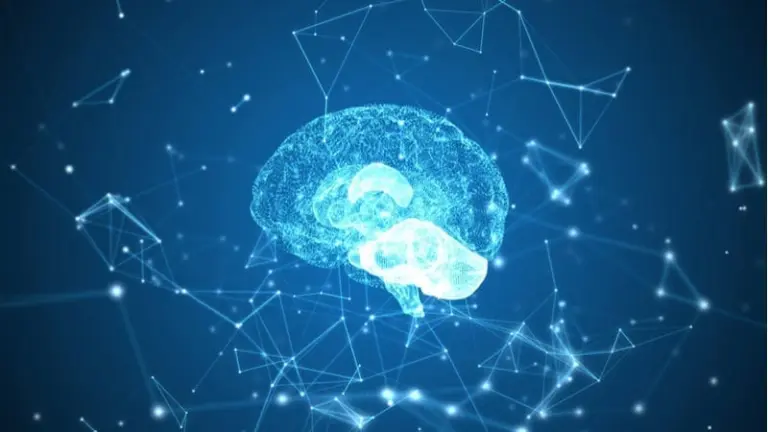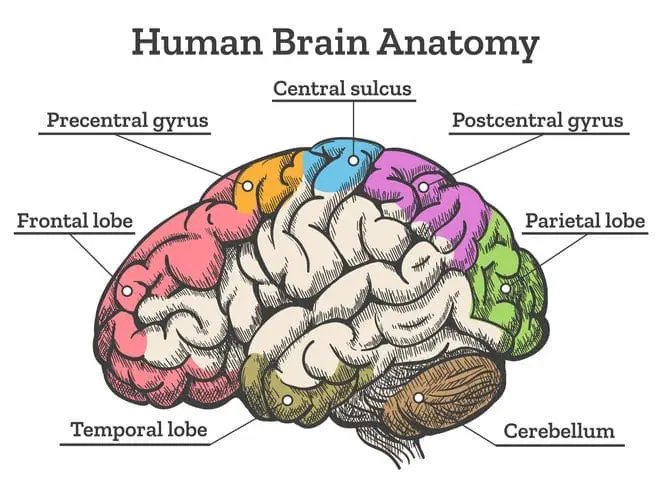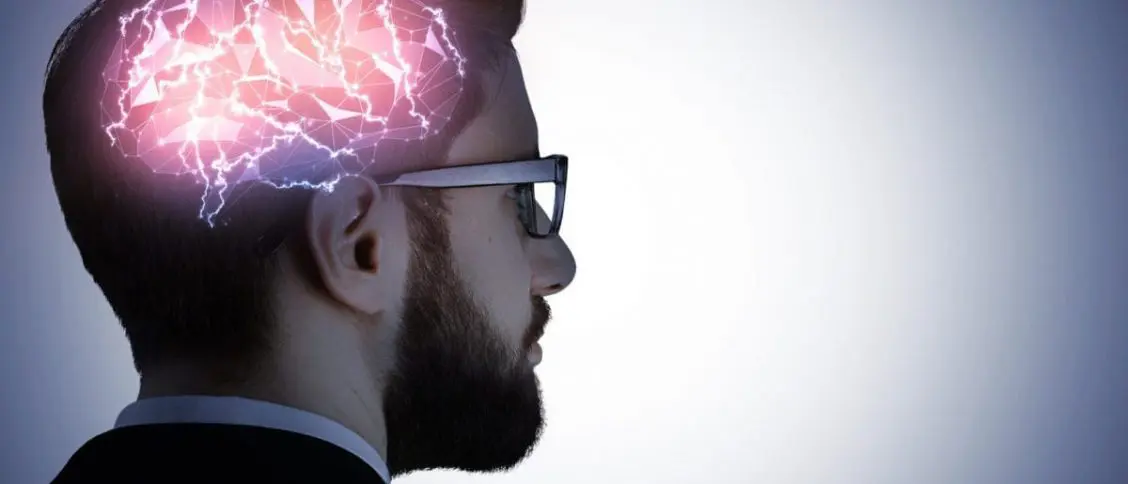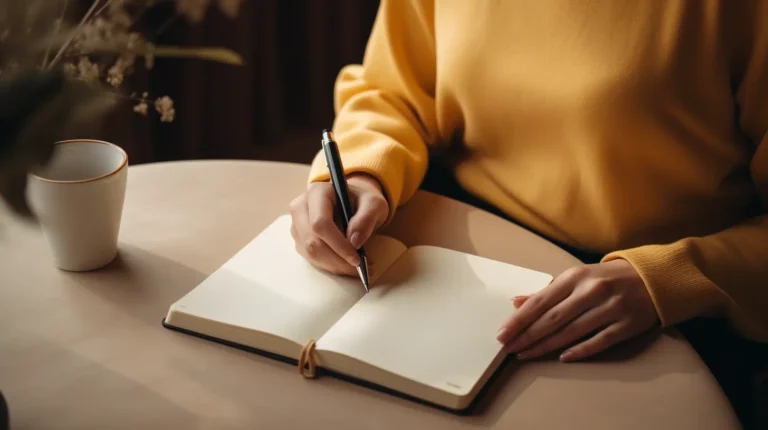The brain is the processor that allows our perception of the world. It’s in a constant cycle of figuring things out. Every moment, your mind is processing data. Taking in new information. Mapping out reality. Understanding what’s going on in the world.
Every day, in each moment, we consider whether or not it’s vital to update our internal map of reality. And it’s the largest part of the brain that’s doing most of this work.
What Are the Parts of the Brain?
Although each part of the brain has its own special function, they all work collectively. The brain can be divided into three basic units: the forebrain, the midbrain, and the hindbrain.
Let’s start at the bottom of the brain and work our way up to the top.
First up is the hindbrain. It’s made up of the upper part of the spinal cord, the brainstem, and the cerebellum. The hindbrain is responsible for controlling your body’s vital functions, like your breathing and heart rate. The cerebellum controls the voluntary actions in the body, such as balance, coordination, and fine muscle control. It’s also responsible for maintaining posture and equilibrium.
The midbrain consists of the uppermost part of the brainstem. Its function is to control fundamental body functions, such as breathing, eye movements, blood pressure, heartbeat, and swallowing.
The forebrain consists of the cerebrum, which is the largest part of the brain. It is also the most highly developed part of the brain. It’s responsible for giving and receiving meaning to information from your sensory organs, like when you read, think, learn, speak, feel, and move. It also controls vision, hearing, and other senses.
What Is the Largest Part of the Brain?
It’s the cerebrum — one of the three parts that make up the most powerful organ in your body.
When you see a picture of the brain, in all likelihood, you’ll notice the cerebrum. Because it’s the biggest part of the brain, it makes up 80% of the overall brain volume. It sits at the topmost part of the organ and is also the most advanced contraption in the known universe, making it also the smartest part of your superbrain.

The cerebrum, being your biggest part of the brain, is the source of all your intellectual activities, like your memories, your imagination, your thought processes, your ability to recognize people and things, your creativity, and so on.
And as the largest part of the human brain, the cerebrum is home to many of the 86 billion neurons found in the grey matter of our brains. Known to many as the “seat of consciousness,” it’s where your perception, memory, and data from the senses come together to make sense of everything.
What Is It Made Of?
The largest part of the brain is mainly made up of nervous tissue: gray matter and white matter.
Gray matter is located in the cerebral cortex and is responsible for putting information together in the cerebrum. White matter, on the other hand, is located in the surrounding regions of the cerebrum and is responsible for carrying nerve signals between regions of the brain and the spinal cord.
The cerebrum is also made up of other important tissues: vascular and fibrous connective tissues. Vascular tissue consists of arteries, cappillaries, and veins that supply the nerve cells with nutrients and removes waste. Fibrous connective tissues make up the meninges that surround the cerebrum, protecting it from infection and mechanical damage.
What Is the Cerebral Cortex?
The outer layer of the largest part of the human brain is the cortex, meaning ‘bark’ in Latin. It makes up about two-thirds of the brain’s total mass, covering most of its structures including the cerebellum.
Measuring two to four millimeters thick, it’s an extremely important layer of your brain. It consists of gray matter that holds 10% of all the neurons of your brain. (It appears gray because the nerves in this area lack the insulation that makes other parts of the brain appear white.)
The cortex consists of folded bulges that create fissures, all adding to the brain’s surface area. This increases the amount of gray matter as well as the amount of information that is processed.
Sensory and motor data are processed in the cortex to enable our sense of consciousness. And, at over 10 billion nerve cells, the peaks and valleys of the cerebral cortex are the processing powerhouse of the largest part of the human brain — the cerebrum.
What Is Its Function?
As the largest part of the human brain, the cerebrum holds a number of responsibilities:
- Thinking
- Controlling your voluntary muscles
- Holding your memories — both short-term and long-term
- Helping with reasoning
Structurally, this largest portion of the brain is split into two halves (better known as hemispheres). Scientists believe that the right side of your brain is responsible for your creative and artistic side, while the left side of your brain is methodical and analytical. However, despite being split, the two hemispheres communicate with each other.
Each hemisphere is further divided into lobes where each section plays its unique role to assist with the function of the largest part of the brain. In total, there are four lobes: the frontal, parietal, occipital, and temporal lobes.

1. Frontal lobe
Responsible for: movement and speech
Being the largest of the four lobes, you can find the frontal lobe at the front of the brain. It’s the hub of your personality, planning, and decision-making. In addition to attention, impulse control, and problem-solving, it handles memory, motor skills, and speech. Without it, you wouldn’t have any inhibitions or moral compass.
2. Parietal lobe
Responsible for: sensing, touch
Positioned just behind the frontal lobe, the parietal lobe helps interpret sensory data from the other parts of the brain. The somatosensory cortex, which processes touch and body sensations, is located here.
3. Occipital lobe
Responsible for: visual processing
This is your visual processing center. Located in the back of the brain, the occipital lobe is involved in reading, color recognition, and other visual information from the retina. Your visual memory is also processed here.
4. Temporal lobe
Responsible for: hearing, memory
The temporal lobe handles visual and verbal memory as well as interpreting reactions and emotions. It allows you to recognize faces, process language, and speech. It’s home to structures of the limbic system such as the amygdala, and hippocampus. These also organize impulses and aid in auditory perception.
Train Your Brain
As the largest part of your brain, the cerebrum isn’t the only portion that keeps your brain running. It works together with the cerebellum and brainstem to ensure your brain is functioning at its optimum.
But your brain’s work is never complete. Each moment, it’s processing data to make sense of your world. Within two-tenths of a second, your brain reacts. And in each moment, we receive data through our senses. Much of this data gets processed in the largest part of your brain, the cerebrum.
Exercising and training the largest part of your brain (the cerebrum) and its counterparts (the cerebellum and brainstem) is a big responsibility. But through learning something new each day, your superbrain grows itself.
Great things always begin from inside.
— Jim Kwik, Author of Mindavalley’s Superbrain Quest
And sometimes, it’s as simple as just taking the next step of your journey.








